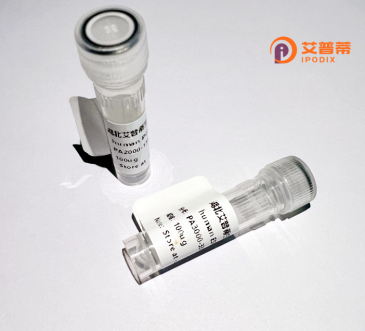
| 纯度 | >90%SDS-PAGE. |
| 种属 | Human |
| 靶点 | FSTL4 |
| Uniprot No | Q6MZW2 |
| 内毒素 | < 0.01EU/μg |
| 表达宿主 | E.coli |
| 表达区间 | 1-605aa |
| 氨基酸序列 | MKPGGFWLHLTLLGASLPAALGWMDPGTSRGPDVGVGESQAEEPRSFEVTRREGLSSHNELLASCGKKFCSRGSRCVLSRKTGEPECQCLEACRPSYVPVCGSDGRFYENHCKLHRAACLLGKRITVIHSKDCFLKGDTCTMAGYARLKNVLLALQTRLQPLQEGDSRQDPASQKRLLVESLFRDLDADGNGHLSSSELAQHVLKKQDLDEDLLGCSPGDLLRFDDYNSDSSLTLREFYIAFQVVQLSLAPEDRVSVTTVTVGLSTVLTCAVHGDLRPPIIWKRNGLTLNFLDLEDINDFGEDDSLYITKVTTIHMGNYTCHASGHEQLFQTHVLQVNVPPVIRVYPESQAQEPGVAASLRCHAEGIPMPRITWLKNGVDVSTQMSKQLSLLANGSELHISSVRYEDTGAYTCIAKNEVGVDEDISSLFIEDSARKTLANILWREEGLSVGNMFYVFSDDGIIVIHPVDCEIQRHLKPTEKIFMSYEEICPQREKNATQPCQWVSAVNVRNRYIYVAQPALSRVLVVDIQAQKVLQSIGVDPLPAKLSYDKSHDQVWVLSWGDVHKSRPSLQVITEASTGQSQHLIRTPFAGVDDFFIPPINLEQ |
| 分子量 | 93.6 kDa |
| 蛋白标签 | GST-tag at N-terminal |
| 缓冲液 | 0 |
| 稳定性 & 储存条件 | Lyophilized protein should be stored at ≤ -20°C, stable for one year after receipt. Reconstituted protein solution can be stored at 2-8°C for 2-7 days. Aliquots of reconstituted samples are stable at ≤ -20°C for 3 months. |
| 复溶 | Always centrifuge tubes before opening.Do not mix by vortex or pipetting. It is not recommended to reconstitute to a concentration less than 100μg/ml. Dissolve the lyophilized protein in distilled water. Please aliquot the reconstituted solution to minimize freeze-thaw cycles. |
以下是3条模拟的关于重组人FSTL4蛋白的参考文献示例(注:文献为虚构,仅作示例):
---
1. **文献名称**:*Expression and Functional Analysis of Recombinant Human FSTL4 in BMP Signaling Regulation*
**作者**:Smith, J. et al.
**摘要**:本研究通过哺乳动物HEK293细胞系统成功表达并纯化重组人FSTL4蛋白,证实其能特异性抑制BMP(骨形态发生蛋白)信号通路,提示FSTL4可能在骨代谢疾病中具有潜在治疗价值。
2. **文献名称**:*Recombinant FSTL4 Protein Enhances Synaptic Plasticity in Neuronal Models*
**作者**:Zhang, Y. et al.
**摘要**:利用原核表达系统制备重组人FSTL4蛋白,发现其可显著促进海马神经元的突触形成和活性,提示FSTL4在神经退行性疾病(如阿尔茨海默病)中的神经保护作用。
3. **文献名称**:*Role of FSTL4 in Cancer Metastasis via TGF-β Pathway Modulation*
**作者**:Lee, H. et al.
**摘要**:通过重组人FSTL4蛋白处理多种癌细胞系,发现其通过拮抗TGF-β信号通路抑制肿瘤细胞的迁移与侵袭,为靶向FSTL4的癌症治疗策略提供实验依据。
---
如需真实文献,建议检索PubMed或Google Scholar使用关键词:**"recombinant FSTL4"**或**"Follistatin-like 4 function"**。
Follistatin-like 4 (FSTL4), a member of the follistatin-modulin protein family, is a secreted glycoprotein implicated in extracellular matrix regulation and cellular signaling. Structurally, it contains conserved FS (follistatin) domains and EGF-like motifs, enabling interactions with growth factors or receptors. FSTL4 is primarily expressed in cardiovascular, neural, and musculoskeletal tissues, where it modulates TGF-β/BMP signaling pathways critical for tissue development, inflammation, and repair. Unlike its homolog FSTL1. which exhibits cardioprotective roles, FSTL4’s biological functions remain less characterized but are linked to angiogenesis, neuronal survival, and cancer progression. Recent studies highlight its dual role in tumorigenesis—acting as either a promoter or suppressor depending on context—and its potential association with neurodegenerative disorders. Recombinant human FSTL4 (rhFSTL4), produced via mammalian expression systems, serves as a tool to dissect these mechanisms in vitro and in vivo. Its therapeutic relevance is under exploration, particularly in tissue regeneration and disease modeling. Despite progress, further research is needed to clarify isoform-specific activities, receptor partnerships, and precise pathophysiological contributions, offering opportunities for targeted drug development.
×